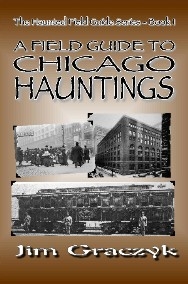| |
A Field Guide to Chicago Hauntings |
 |
|
The following page has been used by permission by the author and Ghost Research Society Press. All pictures and text from this entire site is protected under copyright law. Do not use without permission. Thank you.© 2002/2017 Jim Graczyk A FIELD GUIDE TO CHICAGO HAUNTINGS written by Jim Graczyk, member of the Ghost Research Society. The following are a few of the entries that appear in the book. Also inside the book are maps, and a few short stories.
CLARK STREET BRIDGE - Between Clark and LaSalle Street Bridges. (Wacker Drive 230 N., Clark Street 100 West)
HARPO STUDIOS - Aberdeen and Washington (Aberdeen 1100 W., Washington 100 N.)
EXCALIBUR - 632 N. Dearborn (Ohio 600 N., Dearborn 50 W.)
TITO'S RESTAURANT - 2600 S. Wentworth ( Wentworth 200 W., 2600 S.)
THE LINCOLN FUNERAL TRAIN - 12th St. Depot ( Lake Shore Drive 500 E, Roosevelt 1200)
It was another clear and sunny day, December 30,1903. Though it was cold, it didn't keep the holiday crowd away from the theater. People came from all over the area, many from out-of-town. Everyone wanted to see the popular funnyman Eddie Foy. The entertainment business back then was centered on vaudeville, and plays were the thing to see. The current play Mr. Bluebird was going to be performed during an afternoon matinee. The theater was going to hold about two thousand people, mostly women and children who were on the holiday break from school. Since it being a Wednesday afternoon matinee, hardly any men were present, since most of them worked. Sometime shortly after 3pm during one of the scenes, a spark was seen coming out from one of the stage lights followed by some floating paper that was on fire. At first nobody panicked, thinking it was all part of the act, while some of the cast already made a run for the alley behind the theater. Suddenly, the stage's alleged "fireproof" curtain came rolling down, but suddenly got stuck in the half way position. Now this curtain passed the inspection previously by the City as being "fireproof." As the curtain got caught it fanned the flames out into the audience area. People at that moment panicked and started to make their way to the doors. The front doors of the theater had this clever design that were to swing inward not outward. Most of the side doors of the theater for some apparent reason were locked on this day. The side doors also had these new steel gates, with a locking system that the public was not aware on how to use. There was a fireman on duty but he was insufficiently supplied with firefighting equipment. To make matters even more worst, the tracks where the curtain ran up and down, was made of wood. The curtain, rumor has it, was made of the cheapest material and chances are wouldn't have made much of a difference it was fully deployed down. The blaze was brought under control in a matter of less than thirty minutes once the Fire Department arrived on the scene. By then, tragedy already struck within the first fifteen minutes. Many people in an attempt to flee the fire rushed the doors , only to trap the people in the front, because the doors had to swing inward. Bodies upon bodies piled up in many areas of the building, many passing out from smoke inhalation. People tried to jump from the balcony to the main floor to escape the fire. Others had jumped out the side windows of the theater in an attempt to escape, only to hit the hard pavement. Of course the first that jumped had seriously been hurt or died, while the rest landed on those that made the first attempt, and managed to survive the fall. More people perished as the fire broke out under a escape stairwell. The number of victims peaked around five hundred seventy, some say more close to six hundred people. At least another three hundred people were seriously hurt. To make matters worst, of those killed in the fire, about forty of them were school teachers within the City of Chicago. School was closed that following Monday in remembrance of them. The recovering of bodies took about five hours after the fire was put out. A number of bodies were stacked in the alley, this is how the term "death alley" came about, where relatives would come and make a positive ID. There were also numerous bodies taken to the eighth floor of Marshall Field's department store. There was nobody actually punished for the neglect of the building, money and the right political connections bought the men freedom. One person that did manage to do jail time in connection to the fire, it was a tavern keeper. Some of the bodies were sent to a nearby tavern as a temporary morgue. He apparently was convicted of robbing the dead. The theater once again, was eventually rebuilt and reopened within a few short months. The building did manage to survive for a number of years, and was eventually torn down in 1925. The lot was built upon and housed a number of different things. At the present time it's the Ford Center for Performing Arts. This building is truly extravagant and hosts top name billing. If the building site is haunted, the public doesn't know anything about it yet, and Marshall Fields eighth floor is also unknown. As for the alley, nothing unusual has been reported to this date. The aftermath of this dreadful fire brought about some mandatory changes to theaters that included those nifty EXIT signs and lights, outward opening doors, automatic sprinklers, a fire alarm system, and flame-resistant scenery, props, and costumes. All of the changes that were made can still be seen today in modern theaters and can be traced back to that dreadful day back in December 1903. |
|
|